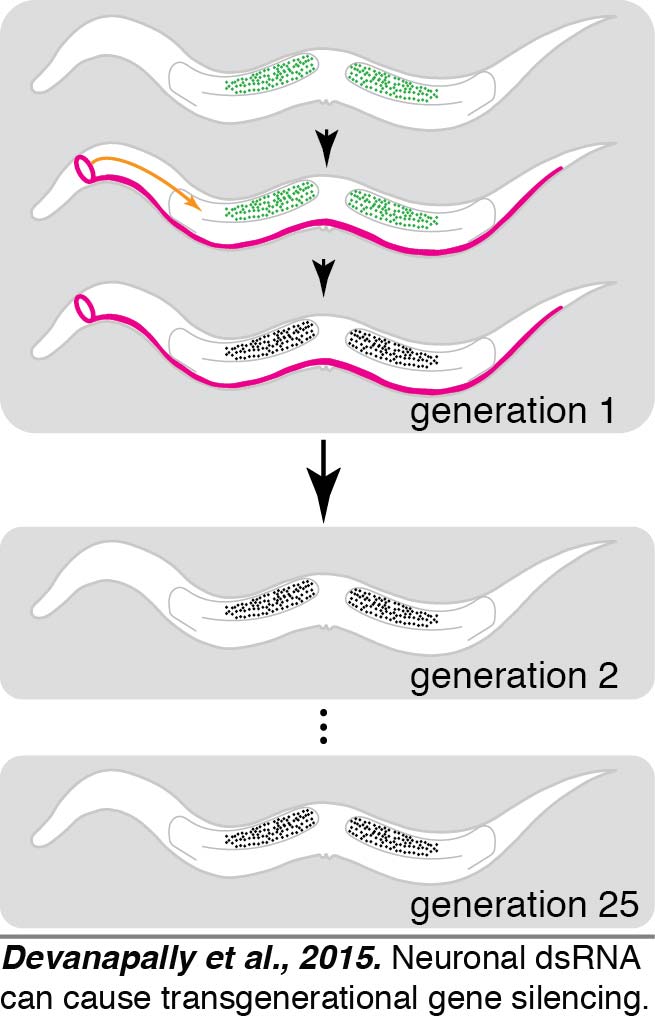Transgenerational RNA Silencing
What happens to our bodies is typically thought to not influence the biology of our descendants. The reason for this view is that the somatic cells that generate our body are separated early in  development from the germ cells that make sperm or egg. This separation had led to the belief in a barrier to communication between somatic cells and germ cells, a concept known as the Weismann Barrier. Our work establishes a way for somatic cells to communicate gene-specific information to germ cells and breaks the Weismann Barrier (Devanapally et al., 2015). We showed that neurons (magenta) of the worm C. elegans can send gene-specific messages in the form of dsRNA to the germline (green) and cause transgenerational gene silencing that can last for more than 25 generations. Neuronal dsRNAs enter germ cells through an importer protein called SID-1, which has homologs in most animals, including humans. These results can have profound implications for our understanding of evolution and behavior. We have begun a UMD-funded program called the Transgenerational Brain Initiative (http://www.fire.umd.edu/streams-TBI.html) that trains ~35 undergraduates each year in original research aimed at discovering which neuron(s) are the best exporters of dsRNA to the germline.
Current models for the transgenerational inheritance of silencing in C. elegans propose chromatin modifications associated with the production of small RNAs that reinforce these modifications in each generation. Most aspects of this model, however, remain to be tested and only a few protein factors required for this process are known. RNAs transcribed from the C. elegans genome that move from neurons to the germline to cause transgenerational gene silencing are unknown.
development from the germ cells that make sperm or egg. This separation had led to the belief in a barrier to communication between somatic cells and germ cells, a concept known as the Weismann Barrier. Our work establishes a way for somatic cells to communicate gene-specific information to germ cells and breaks the Weismann Barrier (Devanapally et al., 2015). We showed that neurons (magenta) of the worm C. elegans can send gene-specific messages in the form of dsRNA to the germline (green) and cause transgenerational gene silencing that can last for more than 25 generations. Neuronal dsRNAs enter germ cells through an importer protein called SID-1, which has homologs in most animals, including humans. These results can have profound implications for our understanding of evolution and behavior. We have begun a UMD-funded program called the Transgenerational Brain Initiative (http://www.fire.umd.edu/streams-TBI.html) that trains ~35 undergraduates each year in original research aimed at discovering which neuron(s) are the best exporters of dsRNA to the germline.
Current models for the transgenerational inheritance of silencing in C. elegans propose chromatin modifications associated with the production of small RNAs that reinforce these modifications in each generation. Most aspects of this model, however, remain to be tested and only a few protein factors required for this process are known. RNAs transcribed from the C. elegans genome that move from neurons to the germline to cause transgenerational gene silencing are unknown.
Back to research
Last updated: Aug 2017
Web Accessibility